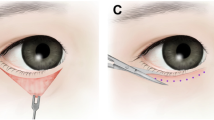Abstract
Background
To investigate the changes of epiblepharon by evaluating the severity of epiblepharon before and after induction of general anesthesia.
Methods
Sixty-three pediatric patients (126 eyes) underwent surgery for epiblepharon between April 2008 and September 2008 (35 females, 28 males; average age: 4.74 years). The severity of epiblepharon in each eye was scored according to skin-fold height (scored 1–4) and area of ciliocorneal touch (scored 1–3) while the patient was in upright and supine positions before induction of general anesthesia and in supine position after induction of anesthesia.
Results
The severity of epiblepharon was significantly reduced by a positional change to supine position and induction of general anesthesia. Skin-fold height scores decreased when patients were moved from upright (estimated mean ± standard error [SE]; 2.98 ± 0.08) to supine position (2.63 ± 0.09) (P < 0.001) prior to induction of anesthesia, and decreased further after induction of general anesthesia (2.12 ± 0.08) (P < 0.001). Ciliocorneal touch scores also decreased after patients were moved to supine position and after induction of general anesthesia (upright: 2.17 ± 0.05; supine: 1.95 ± 0.06; general anesthesia: 1.64 ± 0.07, P < 0.001).
Conclusions
Our study demonstrates that positional changes and general anesthesia using muscle relaxants affect the degree of epiblepharon. Surgeons should be aware of these variations for operative planning of epiblepharon.





Similar content being viewed by others
References
Hayasaka S, Noda S, Setogawa T (1989) Epiblepharon with inverted eyelashes in Japanese children. II. Surgical repairs. Br J Ophthalmol 73:128–130
Johnson CC (1978) Epicanthus and epiblepharon. Arch Ophthalmol 96:1030–1033
Levitt JM (1957) Epiblepharon and congenital entropion. Am J Ophthalmol 44:112–113
Johnson CC (1968) Epiblepharon. Am J Ophthalmol 66:1172–1175
Karlin D (1960) Congeital entropion, epiblepharon, and antimongoloid obiliquity of the palpebral fissure. Am J Ophthalmol 50:487–493
Millman AL, Mannor GE, Putterman AM (1994) Lid crease and capsulopalpebral fascia repair in congenital entropion and epiblepharon. Ophthal Surg 25:162–165
Quickert MH, Wilkes TD, Dryden RM (1983) Nonincisional correction of epiblepharon and congenital entropion. Arch Ophthalmol 101:778–781
Kakizaki H, Leibovitch I, Takahashi Y, Selva D (2009) Eyelash inversion in epiblepharon: is it caused by redundant skin? Clin Ophthalmol 3:247–250
Khwarg SI, Choung H (2002) Epiblepharon of the lower eyelid: technique of surgical repair and quantification of excision according to the skin fold height. Ophthal Surg Lasers 33:280–287
Tse DT, Anderson RL, Fratkin JD (1983) Aponeurosis disinsertion in congenital entropion. Arch Ophthalmol 101:436–440
Kakizaki H, Chan W, Madge SN, Malhotra R, Selva D (2009) Lower eyelid retractors in caucasians. Ophthalmology 116:1402–1404
Kim MS, Lee DS, Woo KI, Chang HR (2008) Changes in astigmatism after surgery for epiblepharon in highly astigmatic children: a controlled study. J AAPOS 12:597–601
Noda S, Hayasaka S, Setogawa T (1989) Epiblepharon with inverted eyelashes in Japanese children. I. Incidence and symptoms. Br J Ophthalmol 73:126–127
Preechawai P, Amrith S, Wong I, Sundar G (2007) Refractive changes in epiblepharon. Am J Ophthalmol 143:835–839
Woo KI, Yi K, Kim YD (2000) Surgical correction for lower lid epiblepharon in Asians. Br J Ophthalmol 84:1407–1410
Khwarg SI, Lee YJ (1997) Epiblepharon of the lower eyelid: classification and association with astigmatism. Korean J Ophthalmol 11:111–117
Shovlin JP, Lemke BN (1996) Clinical eyelid anatomy. In: Bosniak S (ed) Principles and practice of ophthalmic plastic and reconstructive surgery. Vol. 1, 1st edn. Saunders, Philadelphia, p 265
Kakizaki H, Jinsong Z, Zako M, Nakano T, Asamoto K, Miyaishi O, Iwaki M (2006) Microscopic anatomy of Asian lower eyelids. Ophthal Plast Reconstr Surg 22:430–433
Goudsouzian NG (1986) Atracurium in infants and children. Br J Anaesth 58:23S–28S
Debaene B, Beaussier M, Meistelman C, Donati F, Lienhart A (1995) Monitoring the onset of neuromuscular block at the orbicularis oculi can predict good intubating conditions during atracurium-induced neuromuscular block. Anesth Analg 80:360–363
Le Corre F, Plaud B, Benhamou E, Debaene B (1999) Visual estimation of onset time at the orbicularis oculi after five muscle relaxants: application to clinical monitoring of tracheal intubation. Anesth Analg 89:1305–1310
Ungureanu D, Meistelman C, Frossard J, Donati F (1993) The orbicularis oculi and the adductor pollicis muscles as monitors of atracurium block of laryngeal muscles. Anesth Analg 77:775–779
Author information
Authors and Affiliations
Corresponding author
Additional information
None of the authors have any commercial or proprietary interests in the subject matter used in this article.
Authors have full control of all primary data, and we agree to allow Graefe’s Archive for Clinical and Experimental Ophthalmology to review our data if requested.
Registered in www.clinical trials.gov (No. NCT01650688).
Rights and permissions
About this article
Cite this article
Rhiu, S., Yoon, J.S., Zhao, S.Y. et al. Variations in the degree of epiblepharon with changes in position and induction of general anesthesia. Graefes Arch Clin Exp Ophthalmol 251, 929–933 (2013). https://doi.org/10.1007/s00417-012-2186-2
Received:
Accepted:
Published:
Issue Date:
DOI: https://doi.org/10.1007/s00417-012-2186-2




